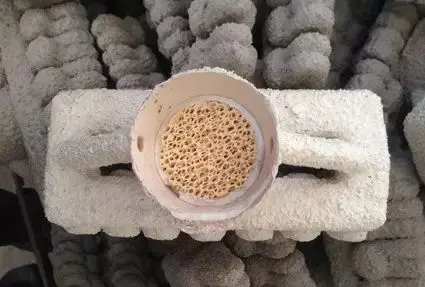
Knowledge
The Application Practice of Filtration Technology in Precision Casting (Part Two)

1. Placement of Filters
Precision castings are generally complex in shape, which brings certain difficulties to the casting process. When using filters, they are mostly placed at the gate position. In practical applications, depending on different castings and requirements, the following methods can be adopted:
1.1 Place in the pouring cup of the mold shell
Reserve a filter seat in the flask pouring cup or use a conical filter seat. After the flask is baked and taken out of the furnace, quickly place the filter at the pouring position. Or, bake and preheat the filter together with the flask before pouring. This helps the molten metal start to pass through and has a better effect.
To facilitate the placement of the filter, a filter base needs to be designed. That is, there should be a 2-millimeter gap between the filter's outer edge and the location where the filter is placed in the mold shell. The support surface should have a base with a width greater than 5 millimeters. The filter can also be made in a truncated cone shape to match the gate. It can be wrapped with fiber cotton and placed directly at the gate position.
1.2 Place the ceramic sprue cup
Place the filter in a dedicated ceramic sprue cup. During the shell-making process, connect the sprue cup to the casting tree. When pouring, place the filter inside the sprue cup for pouring.
1.3 Place in the prefabricated position
Place the filter inside the gating system. Prepare the shell of the gating system with the filter in advance. Reserve openings at the corresponding positions on the shell to facilitate the placement of the filter in the installation seat. During the shell-making stage, place it in the seat and seal it with sodium silicate or silica sol. After curing and drying, it can be used for casting tests.
In addition, the pouring temperature of molten steel should be controlled at the upper limit of the process range, and the pouring speed should be increased to the maximum as soon as possible to avoid casting defects such as cold lap and underpouring.
2 Application Cases
2.1 The Application Effect of Small Precision Castings - Cylinder Heads
The casting is a cylinder head, with the main defects being inclusions and pores. The material is ZG25CrNiMo, the pouring temperature is 1550~1570℃, the pouring weight is 45~50kg, and the shell is made of water glass sand. The shell baking temperature is 840℃, and it is kept warm for 3 hours. A conical frustum-shaped Φ(70~60)×2210ppi zirconia filter is used. The filter is baked in the furnace, and no flow obstruction occurs during pouring, playing a role in filtering and rectifying the flow. After use, the scrap rate has been significantly reduced, and the surface of the casting is smooth, with improved surface quality.
2.2 Application Effect of Large Precision Casting - Valve Body
The casting is a valve body, with a shell made of silica sol. The material is nickel-based alloy. The pouring weight is 300Kg, and the pouring temperature is 1540℃. The pouring time is 12 seconds. One zirconia filter of 150*150*30 (10ppi) is used and placed in a self-made pouring cup. The casting has undergone X-ray flaw detection, and the porosity and slag inclusion defects have been significantly reduced. The surface of the casting is smooth.
2.3 Comparison of Product Quality with and without Filter Castings
It can be seen from Table 1 that after using the filter, the qualification rate of castings has significantly increased, the slag inclusion defects of castings have been reduced, and the porosity scrap rate has been lowered.
2.4 Performance Comparison of Gear Housing Castings Before and After Using Filters
The gear ring is made of ZG45 steel, with a single piece weight ranging from 3 to 6 kilograms. Each set consists of 4 castings. The pouring temperature is 1580 to 1630℃, and the pouring time is 6 to 8 seconds. A zirconia filter of 60*20 (10PPI) is used, and a total of 198 pieces were filtered, all of which were qualified. Before using the filter, the scrap rate was 13%.
The comparison of mechanical properties of the gear sleeve before and after filtration shows that the mechanical properties after filtration are better. As shown in Figure 11, the microstructure analysis of ZG45 steel gear sleeve with and without filtration indicates that the pearlite and ferrite in the matrix are more uniform after filtration than without filtration.
From the above application cases, it can be seen that after using filters, not only the yield and surface quality of the castings have improved and the welding repair rate has decreased, but also the internal quality of the castings, such as mechanical properties, has been significantly enhanced. This indicates that the filtering technology has played a crucial role in improving product quality and elevating the quality of castings.
3. Application Prospects of Filtration Technology
Filtering technology plays a significant role in removing inclusions from molten metals, improving the internal structure and processing performance of castings, enhancing the process yield, qualification rate and mechanical properties of castings, and reducing the comprehensive cost of casting production. With the continuous improvement of the quality of cast steel parts in China and the deepening understanding of filtering technology, foam ceramic filters for cast steel have been increasingly recognized by more and more foundries and will play an increasingly important role in improving the quality and yield of castings.
Vigor has more than 18 years experience on castings. If you have any question and demand of products development or improve your supply chain, please feel free to contact us at info@castings-forging.com



